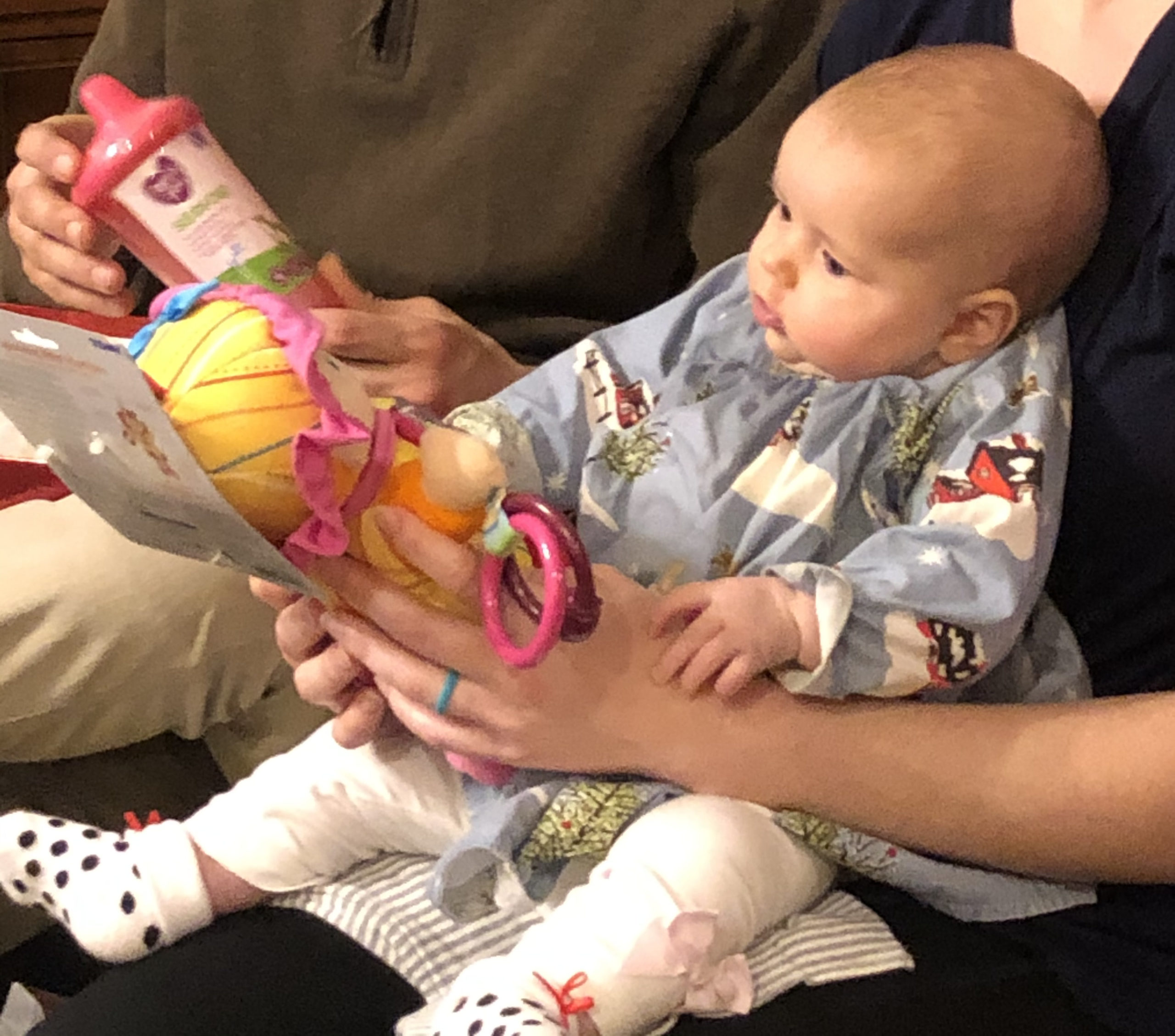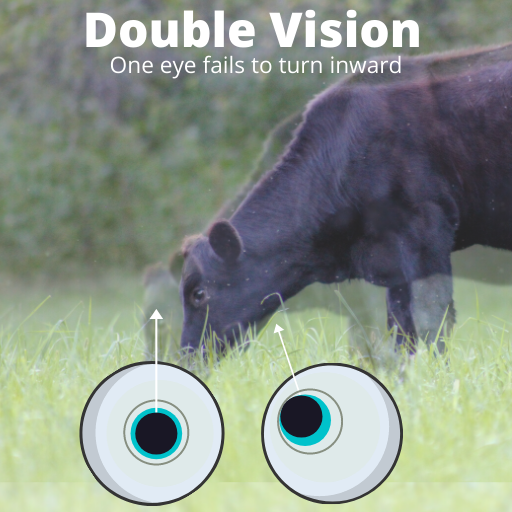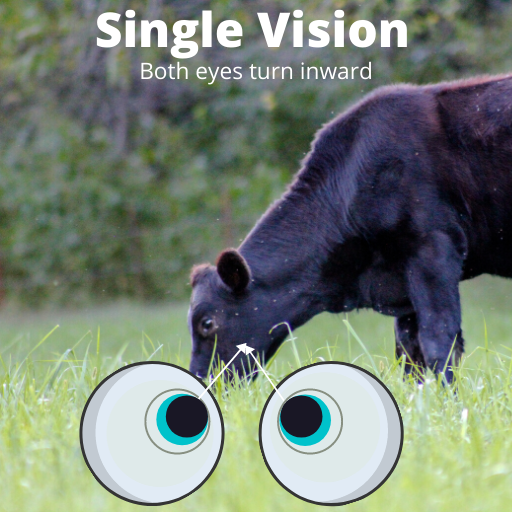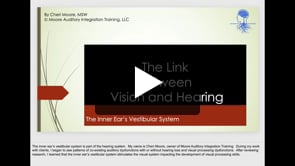Visual Processing Difficulties
Visual processing difficulties are an often neglected area of testing. Visual processing skills develop over time until listening, moving, writing, and reading become instinctive and unconscious enabling you to work at your level of intelligence.
What are Visual Processing Skills?
Learn about visual processing skills in the Moore Auditory-Visual Observation Activity Booklet, What to Observe & How to Observe.
Need Help, Next Step? Call Cheri
Using hearing test results, Cheri Moore helps children and adults improve their ability to respond to auditory integration training and maintain progress.
The Moore Auditory-Visual Questionnaire Report is a powerful advocacy tool when combined with your visual observation worksheet reports. Your reports share specific behaviors and their intensity within these categories: sound intolerance, auditory processing concerns, hearing loss, and visual processing concerns.
Fascinating fact: When you hear a sound your eyes start to move in the direction of the sound milliseconds before your eardrum vibrates.
Video: Amazingly, there are countless interactions between your visual and auditory systems guiding every unconscious and conscious movement.
When What You See Fails to Synch-Up With What You Hear
My experiences as a certified teacher homeschooling a struggling reader caused me to question my knowledge and abilities as a teacher. Modifying curriculum and teaching through hands-on activities was not working. I taught orally and then retaught visually and then taught some more. By the end of my daughter’s year of second grade, my heart started to break. My child saw friends and peers reading and writing with ease. She cried on the outside while I cried on the inside. Why was I unable to teach my own child? What did I not know?
I found answers and started asking the right questions. Imagine my disbelief when I learned my daughter saw letters turning upside down and moving, preventing her from reading with ease. Wow, I had a little genius!
After one year of vision therapy, my daughter became more confident, almost reading on grade level. Two years later, she enjoyed learning and reading.
A Video Activity
Within the video below is an activity helping you learn how well sound energy from your voice travels along your skull bones to both ears.

Overcoming CAPD with Autism
My daughter was diagnosed with autism and central auditory processing disorder (CAPD). We schooled her at home, and even with my background in teaching, it was very difficult. I would have to fight with her to make her begin her school work. While teaching her, she...
A Future for My Daughter: Diminishing L.D. / Sound Sensitivities
Ashylyn did not talk much when she was little and was shy about interacting with people. I sent her to a private Christian school for kindergarten hoping she would come out of her shell. Unfortunately, there were more problems than just shyness. I remember feeling...
CAPD Diagnosis at 21 years; Success with Hearing Aids and AIT
Finding out that my 21-year-old son had a hidden hearing loss (CAPD) was a relief. He is very intelligent. Not getting the right help was causing feelings of depression and hopelessness. Finally, an answer to the questions I have had for so long! He never really fit...
A Relieved Grandmother: CAPD Success with Hearing Aids
I was at my wit’s end when I met Cheri Moore. My oldest granddaughter, whom I had guardianship, had been tested for every possible psychological learning disability, including autism. She was prescribed medication, which did not seem to help. Still, no diagnosis. I...
A Mother’s Journey Into the World of Dyslexia
Diagnosing Dyslexia During the spring of 2007, I attended Dianne Craft’s conference where I learned that dyslexia affected the auditory processing center and the visual processing center. Perhaps I had found help for my daughter’s reading and spelling struggles. She...

Have you ever noticed that a baby stares at your mouth and wondered, “Why?” First, babies see more clearly when looking at a mother’s face while being held versus far away. Secondly, babies learn speech by watching mouth, cheek, and tongue movements while also hearing sounds.
Speech Development Depends on Visual Processing Skills and Hearing
A toddler picks up and drops an object over and over. Do you assume the baby is trying to get you to pick it up? Actually, the toddler is developing depth perception, a visual processing skill.
- Eye-Hand Cordination occurs when the baby reaches and grasp object.
- Depth perception occurs when the baby is unable to reach the object.
- Sound perception occurs when the object hits the floor.



Research Significantly Supports Improved Visual Processing Skills After Vision Therapy
| Randomized, Blind Study (221 children 9-17 yrs.) Convergence Insufficiency 12 week Intervention Program | Convergence Insufficiency Score (lower number means improvements) | % of participant’s meeting goals for near vision convergence skills |
|---|---|---|
| Office-based therapy with home exercises | 15.1 | 73% |
| Office-based non-therapeutic activities with in-home activities (placebo group) |
21.9 | 35% |
| Home-based computer therapy with therapeutic exercises | 21.2 | 33% |
| Home-based therapeutic exercises | 24.7 | 43% |
A greater percentage of children (73%) who received an in-office vision therapy program with in-home eye-exercises made significantly more progress resulting in significantly lower convergence difficulties (15.1) when compared to a much lower percentage of participants (35%, 33%, 43%) making some progress who received vision therapy only at home or in-office, non-therapeutic visual activities with in-home visual activities.
Evidence-based Results for Vision Therapy from 9 research sites. (2008). Randomized clinical trial of treatments for symptomatic convergence insufficiency in children. Arch Ophthalmol; 126 (10):1336-1349. Retrieved from https://www.ncbi.nlm.nih.gov/pmc/articles/PMC2779032/
Visual Processing Difficulties & Behaviors That are Clues
- Headaches after pushing through visual work (reading)
- Emotional, irritable, anxious without apparent cause
- Fearful away from home in safe environments
- Avoids age-appropriate activities like swings, slides
- Unable to ride a bike, feels unsafe
- Child says, “I can’t!” or “I can’t see!”
- Falls walking up stairs for no reason
- Unable to alternate feet going up or down the stairs
- Walks on toes going down a hill
- Holds tightly to someone’s hand while walking
- Reading while looking at paper sideways
- Writes with head tilted
Poor Ear Heath, Chronic Congestion
What happens when preschoolers and children suffer chronic congestion inflaming their eustachian tube with or without an ear infection?
Inflamed eustachian tubes cause mild hearing loss, which distorts sounds making it more difficult to listen with comprehension. Inflammation of eustachian tubes can last up to three or more weeks. Chronic congestion is a significant concern, because it negatively affects your hearing for prolong periods of time.
A study completed by Frank Lin at John Hopkins’ Univ. School of Medicine in 2012, found that participants with a very mild hearing loss at 25 decibels were three times more likely to have fallen in the past. The risk of falling increased almost one and a half times for every ten decibel increase in hearing loss. “Why?”
Decreased hearing under-stimulates your inner ear’s vestibular system. The inner ear’s vestibular system coordinates head, neck, and eye movements needed for keeping your balance while walking on uneven surfaces or up and down hills. Chronic congestion disrupts the stimulation of the vestibular stimulation increasing risk of the development of visual processing difficulties.
“Amazingly, I found in all my clients with poor middle ear health, like chronic congestion or untreated hearing loss, resulted in sound intolerance and double vision during close-up visual work.” Cheri Moore
There are Solutions Towards Improvement
Use the Moore Auditory-Visual Observation Activity booklet to learn about your loved one’s visual and auditory processing skills.
Complete a Moore Auditory-Visual Questionnaire (MAvQ) to receive your MAvQ Report.
Schedule a complimentary phone conference with Cheri.

Overcoming CAPD with Autism
My daughter was diagnosed with autism and central auditory processing disorder (CAPD). We schooled her at home, and even with my background in teaching, it was very difficult. I would have to fight with her to make her begin her school work. While teaching her, she...
A Future for My Daughter: Diminishing L.D. / Sound Sensitivities
Ashylyn did not talk much when she was little and was shy about interacting with people. I sent her to a private Christian school for kindergarten hoping she would come out of her shell. Unfortunately, there were more problems than just shyness. I remember feeling...
CAPD Diagnosis at 21 years; Success with Hearing Aids and AIT
Finding out that my 21-year-old son had a hidden hearing loss (CAPD) was a relief. He is very intelligent. Not getting the right help was causing feelings of depression and hopelessness. Finally, an answer to the questions I have had for so long! He never really fit...
A Relieved Grandmother: CAPD Success with Hearing Aids
I was at my wit’s end when I met Cheri Moore. My oldest granddaughter, whom I had guardianship, had been tested for every possible psychological learning disability, including autism. She was prescribed medication, which did not seem to help. Still, no diagnosis. I...
A Mother’s Journey Into the World of Dyslexia
Diagnosing Dyslexia During the spring of 2007, I attended Dianne Craft’s conference where I learned that dyslexia affected the auditory processing center and the visual processing center. Perhaps I had found help for my daughter’s reading and spelling struggles. She...

